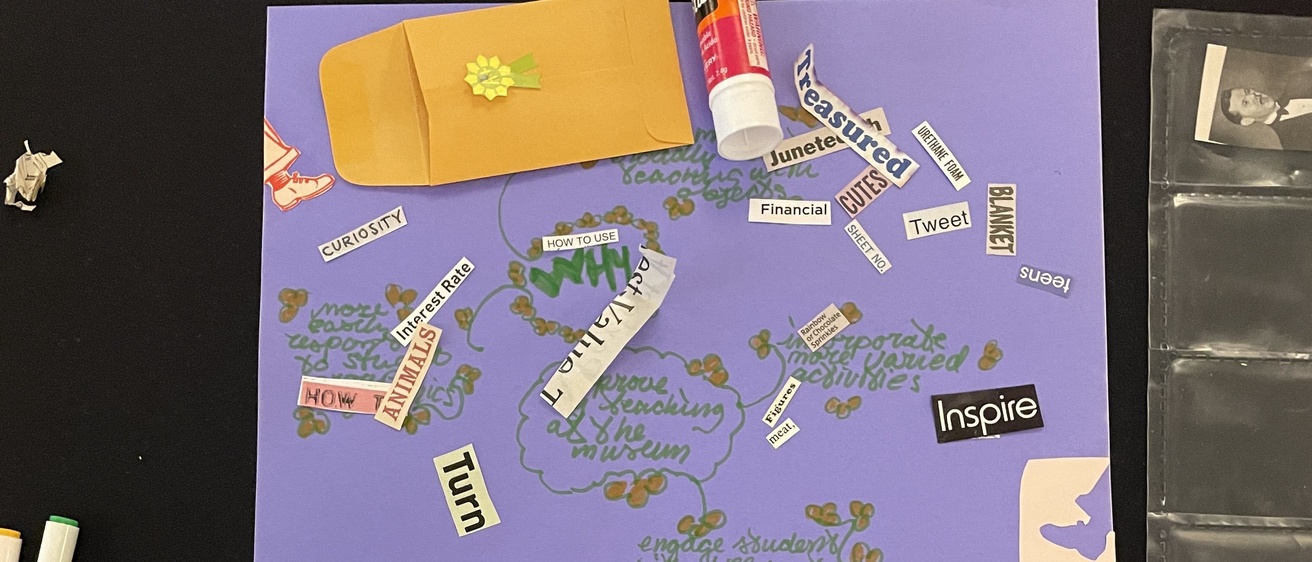Over the first week of April, I was able to attend the 2024 Art Libraries of North America Conference! As a graduate student in the Learning and Engagement department at the Stanley, there were sooooo many activities, talks and workshops that were relevant to the work we do at the museum, as we are constantly working on new ways to engage visitors with our collections. In this blog post I’ll talk a little bit about my experience over the week, and share some of the things I learned.
The first session was at 8:30 on Tuesday morning, where we cut apart weeded material, things deaccessioned by special collections (mostly magazines and periodicals that have many copies floating around out there), and used them to make collages. It felt a little bit wrong, especially once we started gluing this material onto old slides, but it was a nice kind of stream-of-consciousness and silly way to engage with material from the library. I glued little bits around my slide because I really couldn’t bring myself to mess with the image, with exception for one little bag of dried beans.
Later in the day, there were lots of different interesting sessions like “Keep the Framework Weird!” where we workshopped intervention cards using the guidelines of the ACRL (Association of College & Research Libraries) Framework (which you can find here: https://www.ala.org/acrl/standards/ilframework). This was such a useful exercise I think for any organization-- as a kind of “staff” we thought about the guidelines that we work, instruct, and conduct research within. We brainstormed creatively and critically about how to intervene in those structures.
It’s important that we’re always re-questioning the things we know to be true, encouraging everyone to disrupt the power structures that are so present in museums and libraries. We made these prompts into lists, discussed them, and then presented them as cards to the rest of the group. One prompt card that I came up with that got a lot of approval from the group was, “Restate the question in as many words as possible.”
I really like thinking about this idea of restating things into longer form versions, because it’s a little counterintuitive to our mantras of “streamlining” and “efficiency.” Usually we wonder how can we distill the issue into as simple an idea as possible, and deal with it through one action item? This kind of thinking encourages people to reduce complex questions that intersect many facets of life and work, nuanced questions of power dynamics, identity politics and space, into a much less qualitative question which is either “fixed” or “not fixed.” Being extemporaneous and abstract with our questioning of institutions might help facilitate the kind of playful, lighthearted, but genuinely thoughtful innovation which really influences the way we interact with our users in museums and libraries.
So many other interesting discussions took place that week at the ARLiS, panels about reference, teaching with distinctive collections and objects, and there was also a makers space where librarians created manifestos, zines, collages and drawings. One last session I went to for fun was a demonstration on how to make a flag book. To my dismay, more torn up books were used as material, but in the end I wasn’t so disturbed by it.
I made my little flag book out of a beautiful children’s book called The Runaway Bunny. Though of course I wasn’t the first to start ripping it up, another participant at my table eventually slid half of the book in my direction. When I started handling the pages one by one, reading the text, re-writing it, cutting up the illustrations and repasting them in playful ways, I certainly saw the book anew.
It was honestly a deeply meaningful experience for me, when I combined elements of myself as an artist, reader, and admirer of this work of art, into a new thing, that was both me and it. Now it lives on my desk at the museum and I look at it often, it makes me smile.
All in all, the conference was so enriching and I’m excited to take these new ideas for events, activities, and methods for research, into my work at the Stanley Museum of Art.
On the last day of the conference it continued to rain as it had all week long, and by the time I left, the entire Point, a large park in downtown Pittsburgh surrounded by its three rivers, was submerged under their rising waters. I went down there anyways and marveled at the staircases leading you straight into the mucky, shimmering surface of the rivers.
As a native Pittsburgher (as it happens, and yes, that is what we’re called), this sight was nothing new to me, but somehow it felt special. Being at ARLiS, I was being shown new ways to interact with the miraculous environment I work each day in. I thought about prompts for visiting flooded areas, could we make art from the refuge of sticks and garbage that would inevitably wash up after the waters lowered? Would it be a curse to see all this old, discarded material resurface? Or would it be an opportunity for reinvention.
Probably no one, or perhaps one person, will make art from the garbage that washes up the next day; but musing how you would, or what it could mean, just might encourage you to do it the next time the waters rise.
